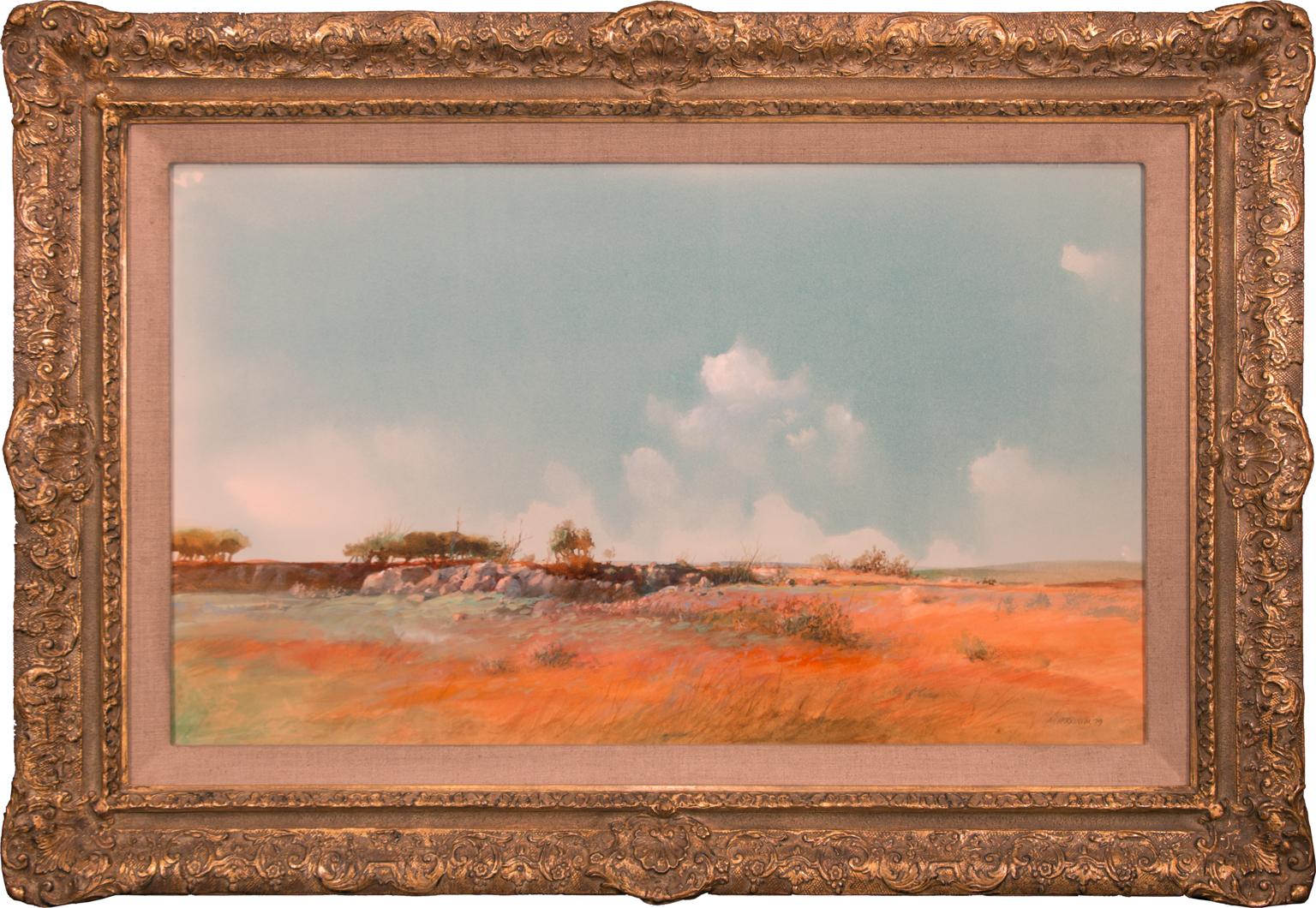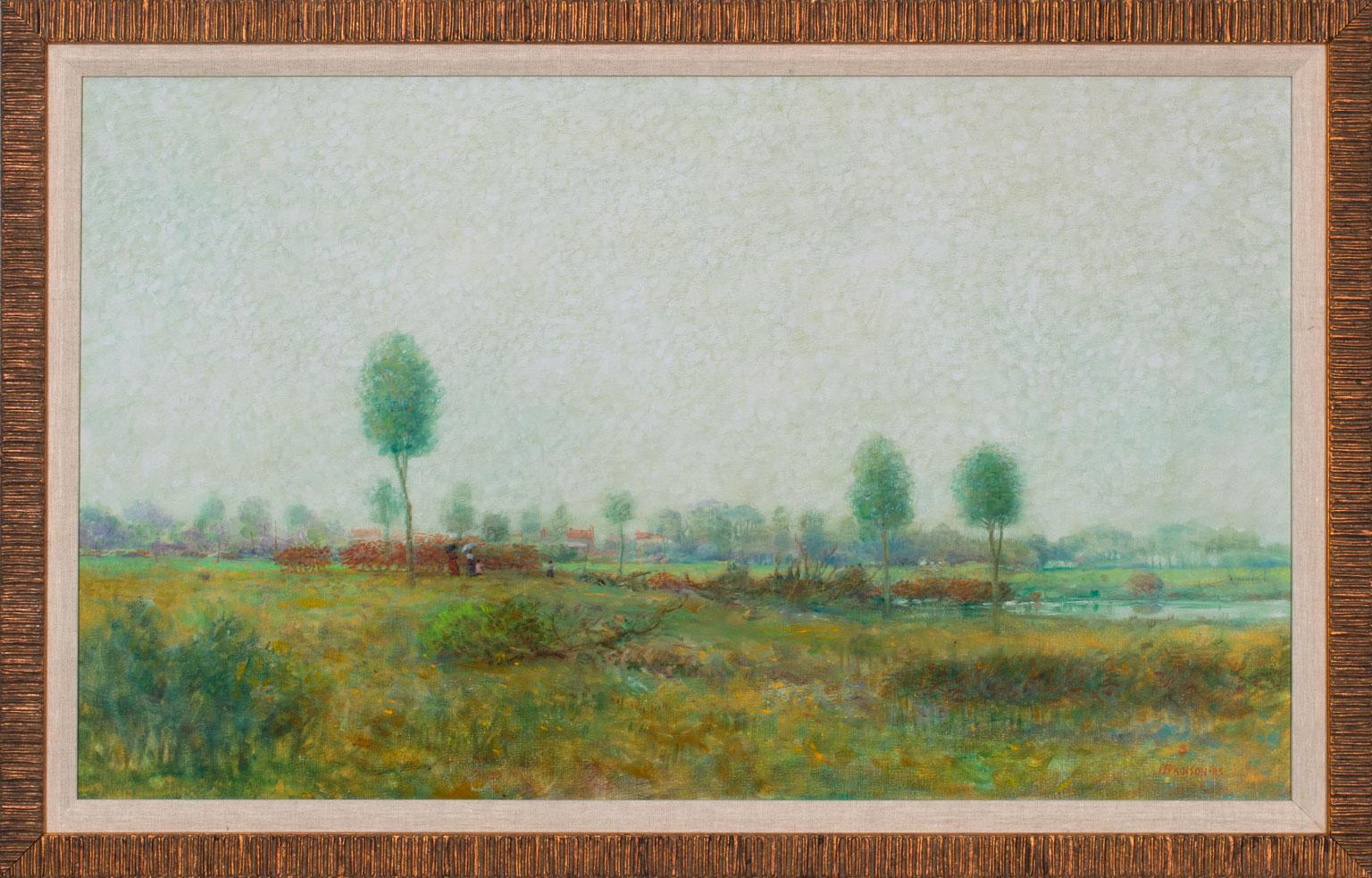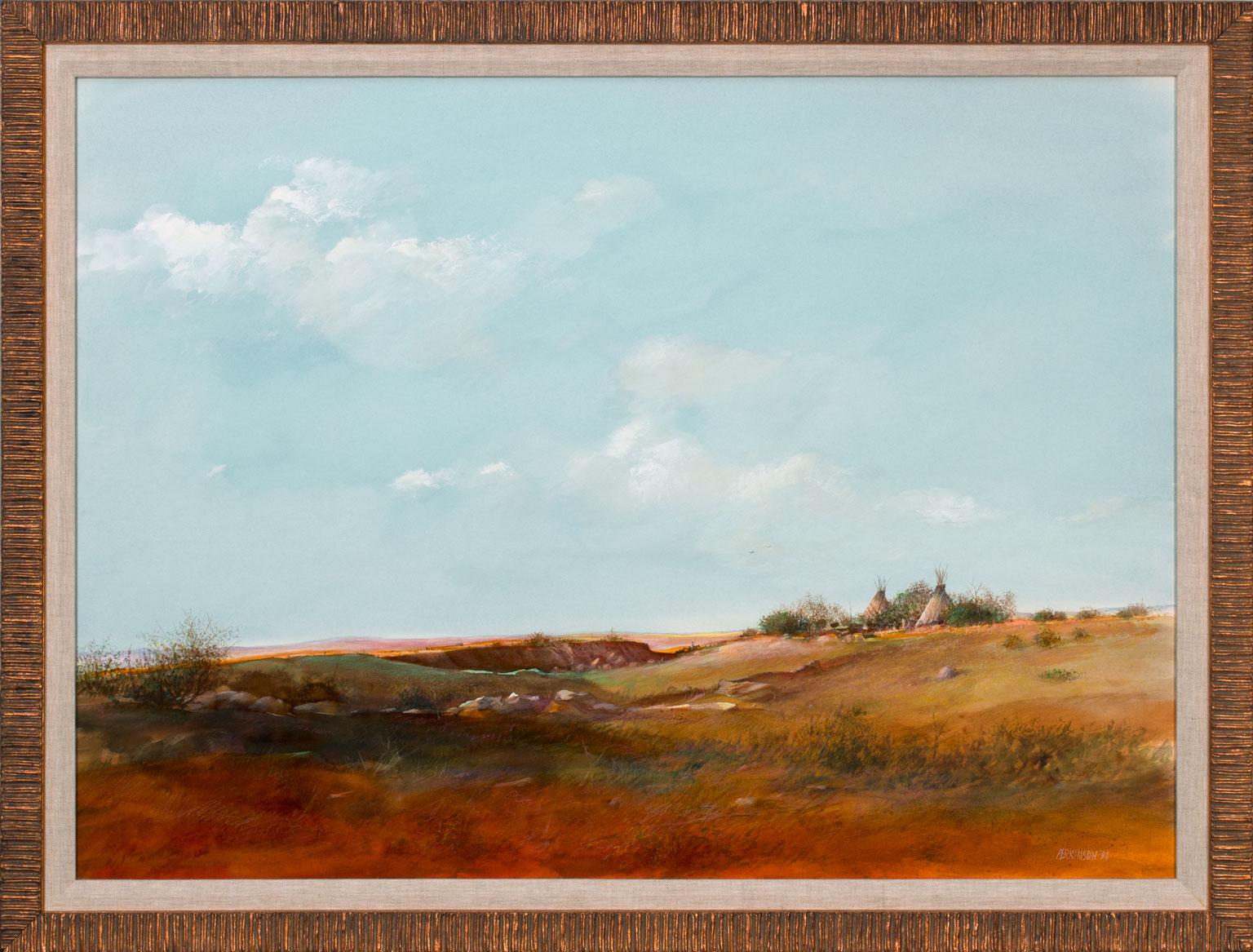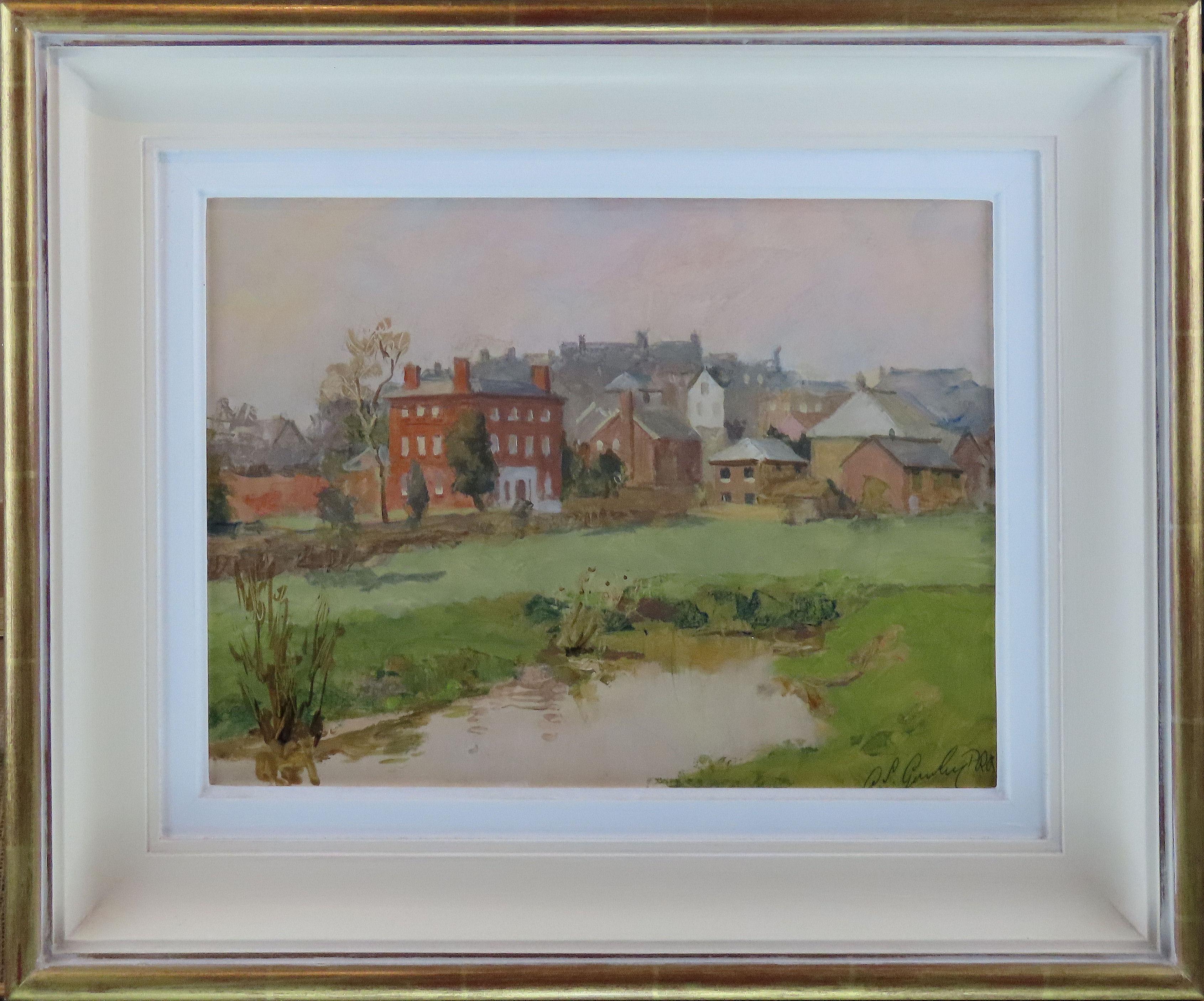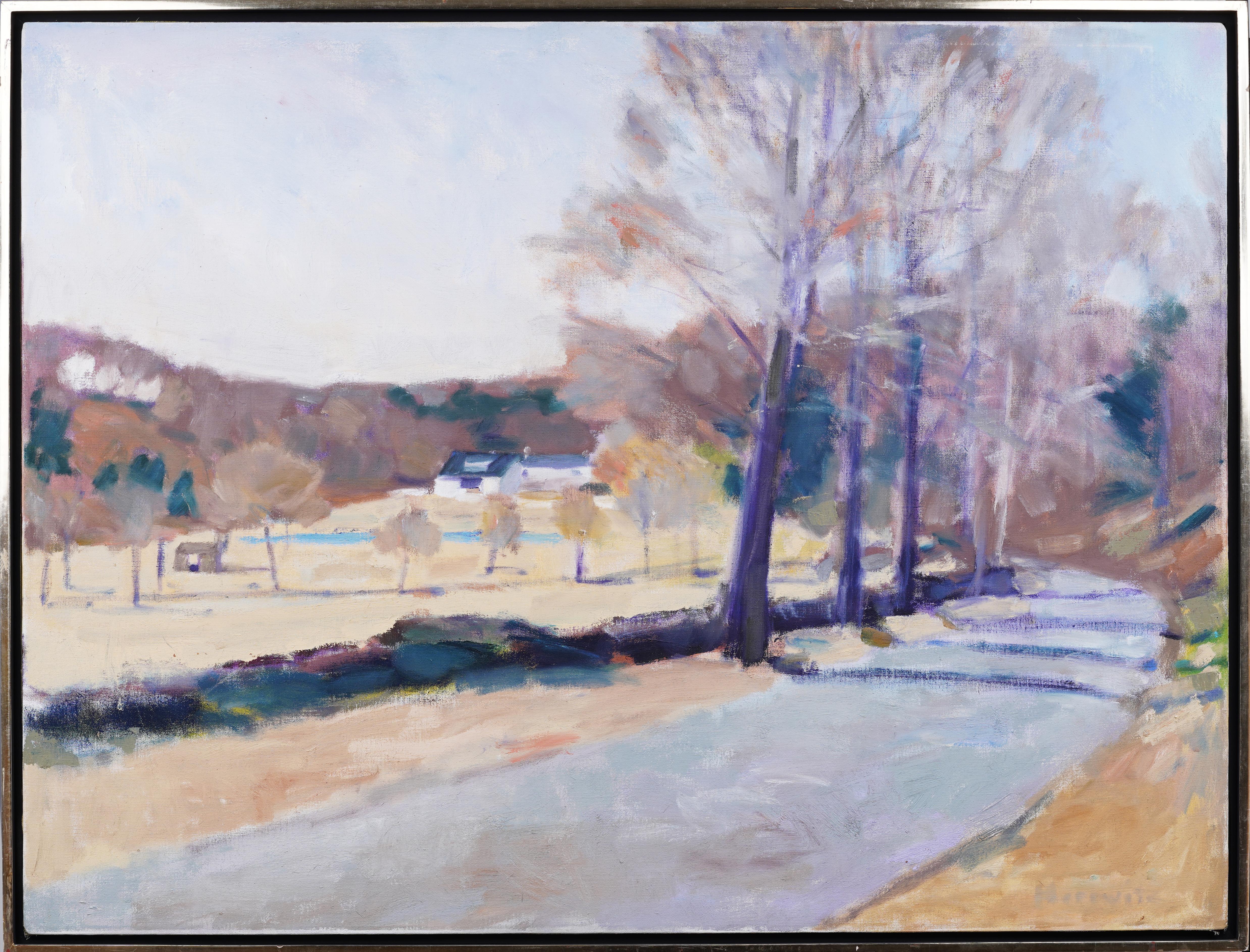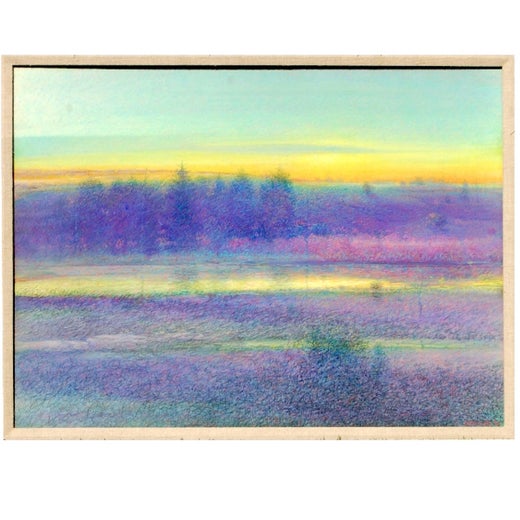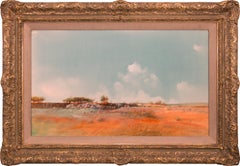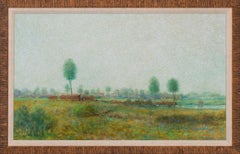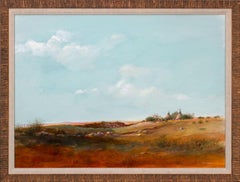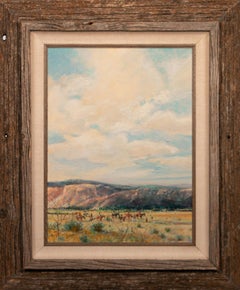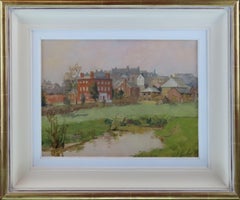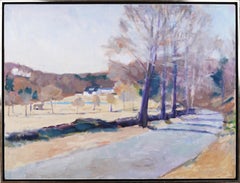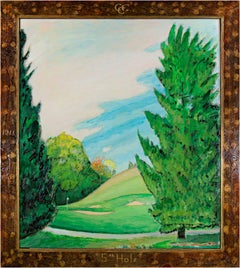"1940 - Number Nine" is an original mixed media on board by Tom Perkinson. His use of saturated violets, vivid yellows, and resplendent oranges pushes color to almost-otherworldly realms. The viewer is invited to step into the painting to explore the scene within and imagine gazing at an easel of a plein-air painter with the sky, clouds, and terrain in full view. Here, Perkinson depicts the 9th hole at the Riviera Country Club in Los Angeles, California. Two players are on the green and one is just at the wood's edge about to attempt to get his ball on the green. The property has certainly been developed extensively with added buildings, but the greens have changed little except for trees that grew up and new vegetation added. Perkinson describes his style of painting as "Romantic Realism," a technique that incorporates two iconic art movements. This style, in combination with the imagination of the artist, produces remarkable results, showcasing Perkinson's keen ability to capture emotion, nature, and life - all in a brushstroke. Both his technical talent and choice of subject matter pair perfectly with its original, custom, gilt frame. This masterful work would make a great addition to an art collection and enhance most any home, perfect for those who have an affinity for landscapes, impressionism, romanticism, realism, plein-air painting, and nature.
For nearly a century, Riviera Country Club's "golf course has withstood the tests of time. The course was developed by the Los Angeles Athletic Club over an 18-month span, opening to critical acclaim in 1927. The LAAC commissioned George C. Thomas, an amateur architect who agreed to take on the project free of charge. It became his crowning achievement and today is considered one of the finest natural layouts in all of golf. As Hale Irwin attests, "The integrity of the course is influenced greatly by the fact that no two holes are alike and the course has been placed, rather than forced, into the land." The beauty in Thomas' design is that each hole presents a new challenge. Johnny Miller, winner of the 1981 Los Angeles Open, described Riviera as, "Definitely one of the greatest, no-nonsense golf courses in the world! It requires a player to play every club in his bag and every shot in his game." As Arnold Palmer once wrote of Riviera, "I consider it one of the great tests of golf.""
Hole 9 at Riviera Country Club is considered "one of the finest long par fours in American golf, running slightly uphill to a deep, narrow green situated attractively beneath the clubhouse. Its initial challenge lies in a pair of perfectly placed fairway bunkers at 225 and 280 yards, with the longer of the two especially affecting the aggressive drive. The approach is also one of Riviera's toughest, for the putting surface, which falls steeply from back to front and features dangerous front-right and back-left pin placements, likely causes more three-putts than any other green.""
In the artist’s own words:
“My color combinations aren’t in the realm of the natural world, because I don’t paint reality; I’m a painter of fiction. I try to paint a sense of place, as though this scene really does exist. I have had my collectors ask me where this scene is, and I just have to point to my head and say I made it up. Thus, I think of my work as romantic realism. I’m painting a certain reality that I’ve invented, inspired by the fascinatingly rich Southwestern landscape.”
“Color gets all the credit, but it’s the values that do all the work. I don’t begin with sketches, because I want to be free to follow the painting in any direction. I start with washes of different values and tints. Then, I begin to look for a landscape. Several directions will appear to me at this time, and then I have to decide on one of them. During these first few moments, I must establish my distance from the scene. Am I a mile away or just across the river? This is one of the first steps, and I have to decide before I can continue. It’s important for working out the perspective and how things are going to relate to one another in the picture. Then, as the landscape evolves, I look for more images to add to the composition.”
Perkinson establishes the work in watercolor and then lets it dry overnight. The next day, he incorporates colored pencil and pastel. “The watercolor seeps into the paper while the pastel sits on the surface, which adds to the illusion of depth and space. I’ll often rub in certain areas and take away others. This technique gives the painting a visual history and its own patina.”
To modulate a passage, add texture, or remove most of the pastel from an area, Perkinson often employs a can of compressed air directed through a fine tube. “The kind of effect I get depends on how far away I hold the can from the paper and how hard I press on the trigger. It produces effects I just can’t get any other way.”
Perkinson also uses cardboard rolls, or stumps, both to blend and to lift pastel from one area to repeat the color in another. “It’s a really effective technique in terms of the subtlety that I can achieve.”
Perkinson uses (1) Lanaquarelle 300-lb. cold-pressed paper; (2) Dr. Ph. Martin’s liquid watercolors; (3) Winsor & Newton watercolor tubes, both gouache and regular transparent varieties; (4) Unison pastels; (5) Sennelier pastels; (6) Nupastels; (7) Prismacolor colored pencils; (8) Permanent walnut drawing ink.
Artist: TOM PERKINSON (1940-)
Title: 1940 - NUMBER NINE
Medium & Surface: ORIGINAL MIXED MEDIA ON BOARD (framed)
Signed: HAND SIGNED AND DATED BY ARTIST LOWER RIGHT AND HAND SIGNED ON VERSO
Year Created: 1985
Country of Creation: UNITED STATES
Image Area Dimensions: 13 x 25 INCHES
Frame Dimensions:* 20.5 x 32.5 x 1.125 INCHES
*This work of art is being sold framed. If you would like to change the frame to better match your style or environment, please contact us for Custom Archival Framing options.
Additional Info: HIGHLY COLLECTIBLE WORK BY TOM PERKINSON IN GREAT CONDITION IN ITS ORIGINAL, CUSTOM, GILT FRAME. FRAME IS IN GREAT CONDITION CONSISTENT WITH AGE AND STYLE.
Artist Info/Bio: ARTIST BIOGRAPHY DOCUMENT IS INCLUDED
Documentation: CERTIFICATE OF AUTHENTICITY IS INCLUDED
About the Artist: Tom Perkinson, born in Indiana in 1940, has become distinguished as a regional painter, known for his work grounded in the visually dramatic landscape of the Southwest.
As a child, Perkinson discovered he had a love for the natural landscape, and a talent for art. He fostered that talent through classes at the John Herron Institute of Art in Indianapolis, and then at the Chicago Art Academy upon graduating from high school.
He received a degree in art from Oklahoma Baptist University in 1964, before moving on to graduate school at the University of New Mexico. Here, among noted works of a larger scale, he continued to paint the landscape, and it was this work that began to reflect a new fascination with the Southwest. He had found what would become an infinite source of inspiration.
Influenced by early painters of the southern Indiana landscape – painters like T. C. Steele, Vawter, Schultze, and Forsythe – Perkinson’s early work focused on landscape, still life, and city scenes. As his love of the New Mexico landscape grew, his work matured, finding influence in J.M.W. Turner, George Inness, and James Mcneill Whistler. Soon, a distinctive, sprung-from-the-imagination style he came to describe as ‘romantic realism’ began evolving.
“None of these places really exist,” he says, “I just make them up as I paint them.” It was this preference for spontaneity that led to watercolor as his preferred medium.
After more than four decades now as an artist painting New Mexico, Perkinson has built a prolific career. His work is included in private and public collections across the globe, and he is represented in the collections of many museums, including the Museum of New Mexico, Santa Fe; the University Art Museum, Albuquerque; and the Eiteljorg Museum of Western Art in Indianapolis. His work is also included in the May 2006 book titled “Landscapes of New Mexico, Paintings From the Land of Enchantment.”
He currently resides in Corrales, New Mexico, where he has lived for 20 years with his wife, renowned jewelry artist Louise Perkinson.
